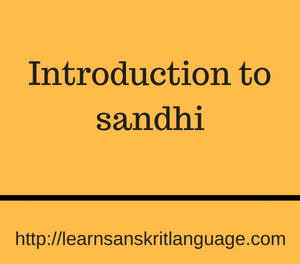In this section we are going to start learning about the Sanskrit grammar, for all those who don’t know what grammar is, grammar is basically a set of rules and patterns of the language, essential for the development of sentences. In order to learn Sanskrit, Sanskrit grammar becomes an essential part of the language which you cannot afford to skip. So let us start with the basics of grammar.
Elephants eat fruits.
This is a basic sentence to start with. From this sentence we can easily figure it out the subject here is the elephant that is doing the action of eating (verb) a fruit (object). This is the most common pattern in all languages; SVO i.e. subject-verb-object. The subject appears first in the sentence, then the action/verb, and then the object. However, it is not same in the case of Sanskrit language. Sanskrit language, on the contrary to the English language, follows the pattern of SOV, i.e. subject-object-verb. The verb in a sentence appears at last.
Now let us compare Sanskrit patter with English:
Elephants eat fruits.
gajāḥ phalāni khādanti
Subject Object Verb
However, unlike the English language, the SOV pattern is not same for all the sentences. This is because some words in Sanskrit carry more information than others; hence the pattern keeps on changing.
Let’s try to change the pattern in both English and Sanskrit and see how they react:
Fruits eat elephants.
Subject Verb Object
phalāni khādanti gajāḥ
Object Verb Subject
In English the sentence has completely lost its meaning, where it seems that the fruit is doing the action of eating, making it completely illogical. In Sanskrit however, it is possible to do so, as Sanskrit has its own set of rules and patterns for forming a sentence.
But what is the reason that makes it possible to rearrange the order? There are two reasons for it
1. Word order adds emphasis:
In Sanskrit, the word order adds emphasis to the sentence. Usually, the first word is paid maximum attention to; we can say that the whole sentence depends on the first word of the sentence. Let us see an example
tvām pṛcchāmi
You I-ask — It is you that I ask.
pṛcchāmi tvām
I-ask you — I ask you.
2. Inflection adds emphasis
Inflection is basically doing small changes in the words. It is done to communicate accurately and precisely so that the listener receives information that the sender wants to. For instance, let us take the word “dance” when we want to say that I am dancing, we say “I dance” but when we want to say that someone else is dancing, we say, “he/she dances”. The small change that you see here is called inflection. Similarly, it can be modified to, “I danced”, “he danced”. The change is the word completely alters the sense, that makes the present tense to past tense.
In the English language, the use of inflected words is very less, but Sanskrit uses them extensively. The importance of inflected words is that it can carry larger information in a limited number of words.
धर्मक्षेत्रे कुरुक्षेत्रे समवेता युयुत्सवः ।
मामकाः पाण्ड्वाश्चैव किमकुर्वत संजय ॥
dharmakṣetre kurukṣetre samavetā yuyutsavaḥ ।
māmakāḥ pāṇḍvāścaiva kimakurvata saṃjaya ॥
दृष्ट्वा तु पाण्डवानीकं व्यूढं दुर्योधनस् तदा ।
आचार्यम् उपसंगम्य राजा वचनम् अब्रवीत् ॥
dṛṣṭvā tu pāṇḍavānīkaṃ vyūḍhaṃ duryodhanas tadā ।
ācāryam upasaṃgamya rājā vacanam abravīt ॥
You must be wondering what it means? Don’t worry, by the end of this section, you’ll be able to figure out and understand all of such highlighted words and phrases that will be provided to you through the course.








